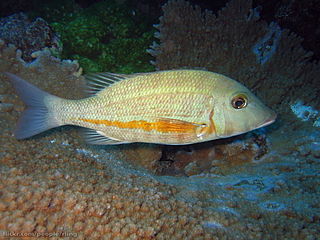
Lethrinidae are a family of ray-finned fishes belonging to the order Spariformes commonly known as emperors, emperor breams, and pigface breams.

The brownspotted grouper, also known as the brown spotted reef cod, brown-spotted rockcod, coral grouper or honeycomb cod, is a species of marine ray-finned fish, a grouper from the subfamily Epinephelinae which is part of the family Serranidae, which also includes the anthias and sea basses. It has an Indo-Pacific distribution but in the northern Indian Ocean this distribution is discontinuous. It forms part of a species complex with two closely related species in the genus Epinephelus.

Lethrinus miniatus, the trumpet emperor, redthroat emperor, sweetlip emperor, Sweetlip Swoose, island snapper, yellowmouth perch, yellowmouth snapper, lipper or nannygal, is a species of marine ray-finned fish belonging to the family Lethrinidae, the emperors and emperor breams. This species is found the eastern Indo-West Pacific region.

The barred mudskipper or silverlined mudskipper, is a species of mudskippers native to marine, fresh and brackish waters from the African coast of the Indian Ocean, to the Marianas and Samoa in the western Pacific Ocean, and from the Ryukyus south to Australia. This species occurs in mangrove forests and nipa palm stands and can cross surfaces of mud while out of the water. This species can reach a length of 19 centimetres (7.5 in) TL. It can also be found in the aquarium trade.
Parasites of the barred mudskipper include Acanthocephalan larvae and the small Opecoelid Digenean parasite in the intestine and described from fish collected in New Caledonia.

The yellowfin goatfish is a species of goatfish native to the Indian Ocean and the Pacific Ocean.

Epinephelus ongus, the white-streaked grouper, specklefin grouper, lace-finned rock-cod, specklefin rockcod, wavy-lined tock-cod, white-speckled grouper or white-spotted rock-cod, is a species of marine ray-finned fish, a grouper from the subfamily Epinephelinae which is part of the family Serranidae, which also includes the anthias and sea basses. It has a wide Indo-Pacific distribution and it is found in brackish waters as well as marine reefs.

Lethrinus is a genus of marine ray-finned fishes belonging to the family Lethrinidae, the emperors and emperor breams. These fishes are mostly found in the Indian and western Pacific Oceans, with a single species in the eastern Atlantic Ocean.

Lethrinus olivaceus, common name longface emperor or long-nosed emperor, is a species of marine ray-finned fish belonging to the family Lethrinidae, the emperors or emperor breams. This species has a wide Indo-Pacific distribution.

Lethrinus atkinsoni, the Pacific yellowtail emperor,, Atkinson's emperor, reticulated emperor, tricky snapper, Tuamotu emperor, yellow morwong or yellow-tailed emperor is a species of marine ray-finned fish benomging to the family Lethrinidae, the emperor breams and emperors. This fish is found in the Western Pacific Ocean.

Lethrinus erythracanthus, the orange-spotted emperor, orangefin emperor, and yellow-spotted emperor, is a species of marine ray-finned fish belonging to the family Lethrinidae. This species is found in the Indo-Pacific region.

Lethrinus mahsena, common names the sky emperor, mahsena emperor, and cutthroat emperor, is a species of emperor fish. It grows to 65 cm (26 in) in length, but is commonly found at between 35 and 45 cm. This fish may be yellow to greenish-blue or olive-grey, becoming paler toward the belly. It is a non-migratory, reef-associated fish that has a high commercial value.

Lethrinus nebulosus, the spangled emperor, green snapper, morwong, north-west snapper, sand bream, sand snapper, sixteen-pounder, sharie, sheri and yellow sweetlip, is a species of marine ray-finned fish belonging to the family Lethrinidae, the emperors and emperor breams. This species is found the Indo-West Pacific region.

Lethrinus rubrioperculatus,the spotcheek emperor, red-eared emperor, red-ears, red-edged emperor, scarlet-cheek emperor, and spot cheek emperor, is a species of marine ray-finned fish belonging to the family Lethrinidae, the emperors or emperor breams. This species has a wide Indo-Pacific distribution.

Pseudorhabdosynochus is a genus of monopisthocotylean monogeneans, included in the family Diplectanidae. The type-species of the genus is Pseudorhabdosynochus epinepheli .

The whitespotted grouper, also known as the rankin cod, ocellated rockcod, small-spotted cod, white-spotted reef-cod or whitespotted rockcod, is a species of marine ray-finned fish, a grouper from the subfamily Epinephelinae which is part of the family Serranidae, which also includes the anthias and sea basses. It has an Indo-Pacific distribution. It is closely related to two other species of white spotted groupers in the genus Epinephelus.
Calydiscoides is a genus of monopisthocotylean monogeneans, included in the family Diplectanidae.

Hamacreadium cribbi is a species of digenean, parasitic in the lethrinid fish Lethrinus miniatus. The species was collected off New Caledonia.
Pseudopycnadena is a genus of trematodes in the family Opecoelidae.

Jean-Lou Justine, French parasitologist and zoologist, is a professor at the National Museum of Natural History in Paris, France, and a specialist of fish parasites and invasive land planarians.

Lethrinus crocineus, the yellowtail emperor, is a species of marine ray-finned fish belonging to the family Lethrinidae, the emperors and emperor breams. This fish is found in the Indian Ocean.


















